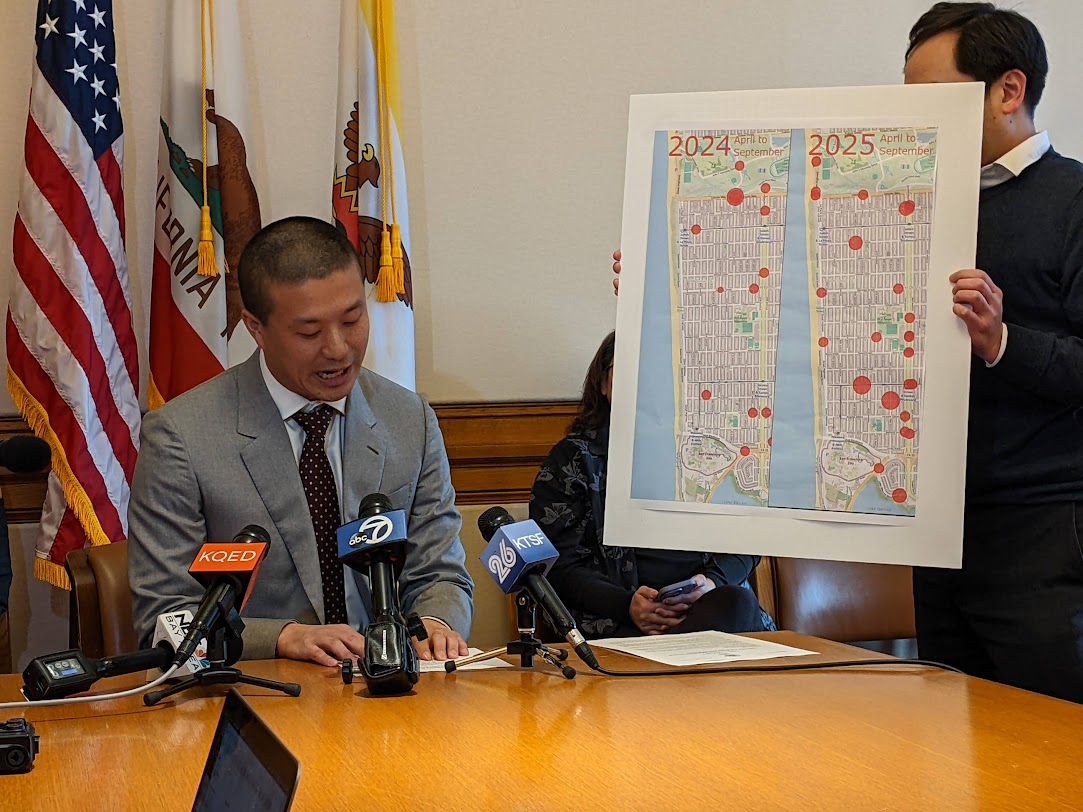
BART staff has shot down a proposal from Director Robert Raburn to allow commuters to bring bicycles aboard the back cars of rush hour trains. In a memo [pdf] to the BART Board, Executive Planning and Budget Manager Carter Mau recommended maintaining the current policy, which prohibits bicycles aboard its most crowded trains during peak hours.
Raburn couldn't be reached for comment but BART Director Tom Radulovich said the response from staff was frustrating. He said they've been "stonewalling" the issue for years.
"I think the BART staff need to be doing more to expand bike access to all trains at all times," he said. The issue is not dead yet, however. Radulovich said the board could revive the proposal and call for a public hearing.
San Francisco Bicycle Coalition (SFBC) Executive Director Leah Shahum said "BART is forgoing a major source of new riders and new revenue" by "refusing to even consider easing the existing black-out period for bikes and allowing escalator access for bikes."
"We urge BART to modernize their approach to bicycle access to support the growing number of people who bicycle in the Bay Area and depend on regional transit, from lawyers to waiters to architects to small business owners," she said.
According to an article on BART's website, "while BART ridership has grown about 15 percent [since 2002], the number of riders bicycling from home to BART rose almost 65 percent, from 2.5 percent of all passengers to 4.1 percent."
But "BART has unfortunately been reducing the lengths of trains to attempt to cut costs without opening up access to cyclists on these trains (which could boost ridership and generate more revenue)," says the SFBC's website.
Mau, who addressed the memo to BART Director Thomas Blalock, cited six reasons for the decision:
1) There will likely be insufficient capacity for bikes on the last car of trains during the peak period causing confusion, queuing on the crowded platform and spillover into adjacent cars.
2) It will be very challenging to enforce this policy. Once bicyclists are on the platform, if the last car is crowded they will likely board other cars (cars that may become more crowded as the train progresses).
3) This would permit bikes on crowded rush-hour platforms potentially leading to safety concerns and conflicts with other passengers.
4) Vertical circulation is already crowded in busy stations. Allowing more bicycles in the system during peak periods would further tax busy stairways and elevators.
5) Overall this would complicate the enforcement issue for the BART Police Department.
6) As ridership increases, trains will be getting more crowded and room for all passengers will be impacted. When new cars start deploying and potentially there may be more train capacity, we may have an opportunity to revisit this policy.
BART is in the process of updating its Bicycle Master Plan and surveyed riders earlier this month "to understand how and why people access BART today to be able to understand what encourages BART passengers who can bicycle to BART to do so, rather than drive to their station," according to survey consultant Victoria Eisen.
But Shahum said the SFBC is "concerned that the current Bicycle Master Planning process omits the two most important issues: greater on-board access for bicycles and better station access."
The next generation of BART cars could potentially provide better accommodations for bikes, but Radulovich says they're "a decade away."
In lieu of expanding bike access aboard trains, Mau's memo recommended "clear communication regarding when bikes are and are not allowed on trains" and "continuing to improve bike parking at stations to give riders a safe, secure parking option."
Mau pointed to recent parking additions at the Ashby and 19th Street stations as well as plans to add bike stations and lockers at Civic Center and MacArthur. BART also plans to add "up to 1,000 electronic lockers at 25 stations over the next few years," according to the memo.
Radulovich said staff has been slow to act on bike parking expansion and pointed out that it won't address the core issue for riders who need to use their bikes on both ends of a trip.
East Bay Bicycle Coalition Executive Director Renee Rivera called Mau's citation of "safety concerns and conflicts with other passengers" on platforms at rush hour "a total non-issue."
"The platforms have plenty of room for people to be there with their bikes," said Rivera.
Restrictions at 12th and 19th Street stations in downtown Oakland, said Rivera, prevent riders with bikes from entering the stations during rush hour, even if they want to access trains that are unrestricted at that time.
"They are a real barrier to people and totally unnecessary," she said.
On its website, the SFBC urges BART to make numerous access improvements to BART stations, "including wide fare gates that allow wheelchairs and bicycles through, stair channels to allow cyclists to wheel their bikes up and down stairs, and improved bike parking, such as racks inside the paid areas, on demand bike lockers, and bike stations."
Radulovich said concerns about circulation in some BART stations like Embarcadero are legitimate, but that staff is falling back on the excuse after years of citing train capacity as the issue. BART has added some room for bikes over the years when it refurbishes cars.
"I just want to know, 'what do you need to do to fix this?'" he said. "We need to get our act together on capacity."
Cities like Portland, Oregon have found solutions to better accommodate bicycles on commuter trains. Portland's MAX rail system provides hooks near doorways to allow passengers to hang their bikes, providing more bike capacity with less space.

"I'd love to see BART consider on-car bike parking racks," said Rivera. "That would solve the issues brought up in the memo around people being able to get on and off the cars during peak hours."
The SFBC has also urged allocating dedicated space "for bikes so that they won't interfere with other passengers and can be stowed safely for the duration of your trip."
"It is very hard right now when trains are full to get bikes on and off because of the way the BART cars are configured with the seats right next to the doorway," added Rivera.
But more crowded systems like the New York City subway, Radulovich pointed out, allow bikes aboard at all times and rely on "a common sense rule."
"You don't take your bike on if it's too crowded," he said. "Someone will yell at you. I think people in the Bay Area are both a little more polite and tend to be more rights-conscious."
"That whole 'common sense of how to share space' thing, we're not as good as New Yorkers are at it because we don't live in crowded conditions."





